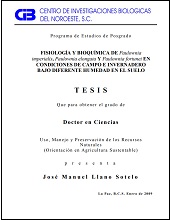Fisiología y bioquímica de Paulownia imperialis, Paulownia elongata y Paulownia fortunei en condiciones de campo e invernadero bajo diferente humedad en el suelo
Author
José Manuel Llano Sotelo
Metadata
Show full item recordAbstract
"La Paulownia es un árbol de crecimiento rápido con potencial en la producción de madera. Esta madera se emplea para hacer muebles, instrumentos musicales y pulpa para papel. Por otro lado, el agua es de los principales factores que influyen en el crecimiento y desarrollo de las plantas. El objetivo general de la tesis fue determinar cambios en las condiciones fisiológicas en Paulownia bajo estrés hídrico. Se determinó el tratamiento de humedad a emplear en el suelo en el experimento. Se realizaron análisis fisiológicos (fotosíntesis, conductancia estomática, transpiración) y bioquímicos (prolina, peroxidasa), así como observaciones en el microscopio electrónico (número de estomas, tamaño de estomas, número de tricomas) en muestras de hojas desarrolladas en invernadero y el campo. Se determinaron los porcentajes de humedad en el suelo, para realizar los experimentos. Fueron de 33, 16 y 8%. El estudio se dividió en tres etapas. La primera etapa consistió en las mediciónes fisiológicas en P. imperialis, P. elongata y P. fortunei desarrollada en el invernadero y el campo al someterse a diferente humedad en el suelo. La segunda etapa consistió en las mediciones bioquímicas en P. imperialis, P. elongata y P. fortunei desarrolladas en el invernadero y el campo al someterse a diferente humedad en el suelo. La tercera etapa consistió en las observaciones en microscopio electrónico en muestras de hojas de P. imperialis, P. elongata y P. fortunei que crecieron en el invernadero y el campo. En el invernadero en las tres especies, la conductancia estomática, transpiración y temperatura de las hojas mostraron diferencias significativas al someterse a diferente humedad en el suelo. A capacidad de campo la fotosíntesis fue mayor en P. fortunei y P. elongata y menor en P. imperialis. En el campo P. imperialis presentó mayor fotosíntesis y eficiencia de uso del agua que P. elongata y P. fortunei. Esta última presentó mayor transpiración y conductancia estomática que P. imperialis y P. elongata. En el invernadero los pigmentos disminuyeron al ser menor la humedad en el suelo. Sobresaliendo en la disminución la clorofila y el ß-caroteno. La peroxidasa disminuyó en P. imperialis. En tanto que en la prolina no se tuvieron diferencias significativas al disminuir la humedad en el suelo. En P. fortunei y P. imperialis se encontraron diferencias significativas en proteína total en los diferentes niveles de humedad en el suelo..." "Paulownia is a tree of rapid growth with potential in the production of wood. This wood is used for make furniture, musical instruments and pulp for paper. Besides, water is of the principal factors that have influence in the growth and development of the plants. The general objective of the tesis was determine changes in the physiological conditions in Paulownia under hydric stress. The treatment of moisture to use in the soil in the experiment was determinated. Physiological analysis were realized (photosynthesis, stomatal conductance, transpiration) and biochemical (proline, peroxidase), like that observations in the electronic microscope (stomatal number, stomatal size, tricomes number) in samples of leaves developed in greenhouse and field. Percentages of moisture in the soil were determined, for do the experiments. Were 33, 16 and 8%. The study was divided in three stepes. The first step consisted in the physiological measures en P. imperialis, P. elongata and P. fortunei developed in the greenhouse and the field with undergo at different soil moisture. The second step consisted in the biochemical measures in P. imperialis, P. elongata and P. fortunei developed in the greenhouse and the field with undergo at different soil moisture. The third step consisted in the observations in electronic microscope in samples of leaves of P. imperialis, P. elongata and P. fortunei that grew in the greenhouse and the field. In the greenhouse in the three species, stomatal conductance, transpiration and temperature of the leaves showed significative differences undergo at different soil moisture. At field capacity photosyntesis was higher in P. fortunei and P. elongata and lower in P. imperialis. In the field P. imperialis presented higher photosynthesis and water use efficiency than P. elongata and P. fortunei. This last presented higher transpiration and stomatal conductance than P. imperialis and P. elongata. In the greenhouse the pigments decreased with less soil moisture. Stand out in the decrease the chlorophyll and ß-carotene. Peroxidase decreased in P. imperialis. As much as proline haven´t significative differences with decrease moisture in the soil. In P. fortunei and P. imperialis significative differences was found in total protein in the different levels of humidity in the soil. In P. elongata didn´t present significative differences..."
Collections
Related items
Showing items related by title, author, creator and subject.
-
PROMOCIÓN DEL PERIFITON PARA EL CULTIVO DE CAMARÓN BLANCO: HACIA UNA ACUICULTURA ECOLÓGICA
DOMENICO VOLTOLINA LOBINA; JUAN MANUEL AUDELO NARANJO; MARIA DEL ROSARIO PACHECO MARGES -
Suelo y Erosión
YOLANDA LOURDES MAYA DELGADO


